19 Birds With Orange Chests and Bellies: How to Properly Identify Each Kind
Telling apart birds with orange chests and bellies can be a task when they’re so abundant in nature. The quick and somewhat erratic temperament of birds can make identification difficult on the fly, especially when they share such defining characteristics.
That’s where this guide comes in handy! Here are 20 birds with orange chests and bellies plus their identification tips to make bird-watching and identifying a breeze.
1. Eastern Bluebird (Sialia sialis)
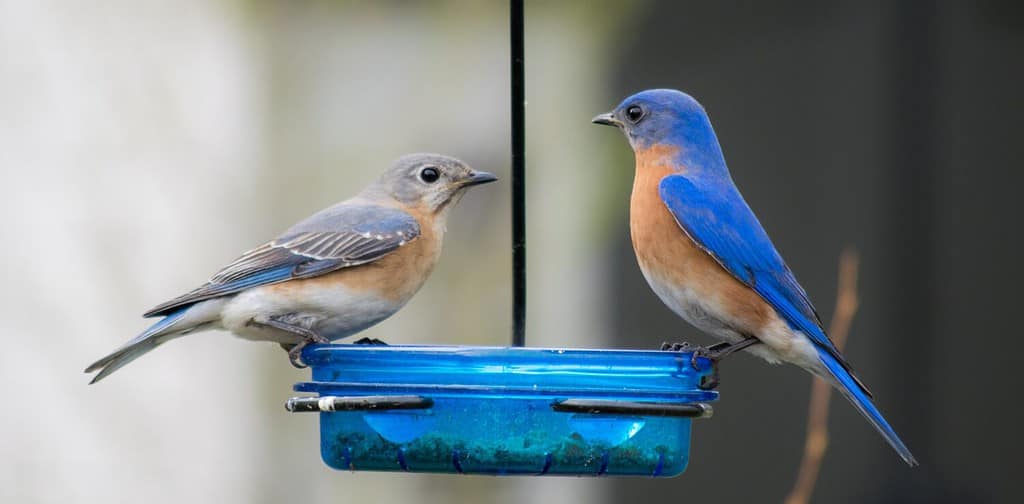
©J Zdunczyk/Shutterstock.com
If you’ve ever noticed a bright blue-backed bird with an even brighter orange chest, you’ve likely just encountered an Eastern bluebird. This bird lives mostly in the eastern half of the United States and into Mexico and Canada. Like many bird species, the males are the most vividly colored. Females still sport the orange chest and blue back, but the colors are a bit more muted to look a bit more gray than the brilliant coloration of the males. A male Eastern bluebird has some white on its belly, too.
You can find Eastern bluebirds hanging out on telephone wires or other high structures. These birds will hit the ground to forage around and tend to build nests in natural cavities, like holes in trees or nest boxes.
2. American Robin (Turdus migratorius)
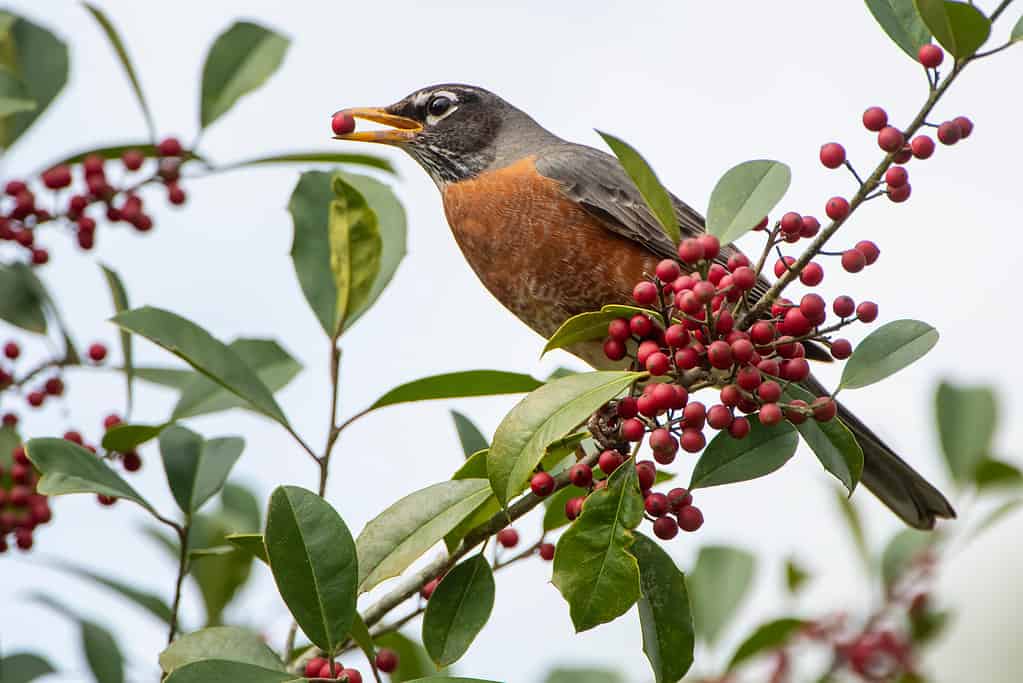
©Bonnie Taylor Barry/Shutterstock.com
This is one of the most common orange chested/bellied birds of the Thrush family in the United States. It can be found everywhere in North America, save for the very southern tip of Mexico. This bird has a black to brownish or gray back and head with a warm, comforting orange underbelly and chest. They also tend to have yellow beaks.
The American robin comes can be seen year-round across the continental US and breeds in Canada. They migrate south to Mexico for the winter.
3. Allen’s Hummingbird (Selasphorus sasin)
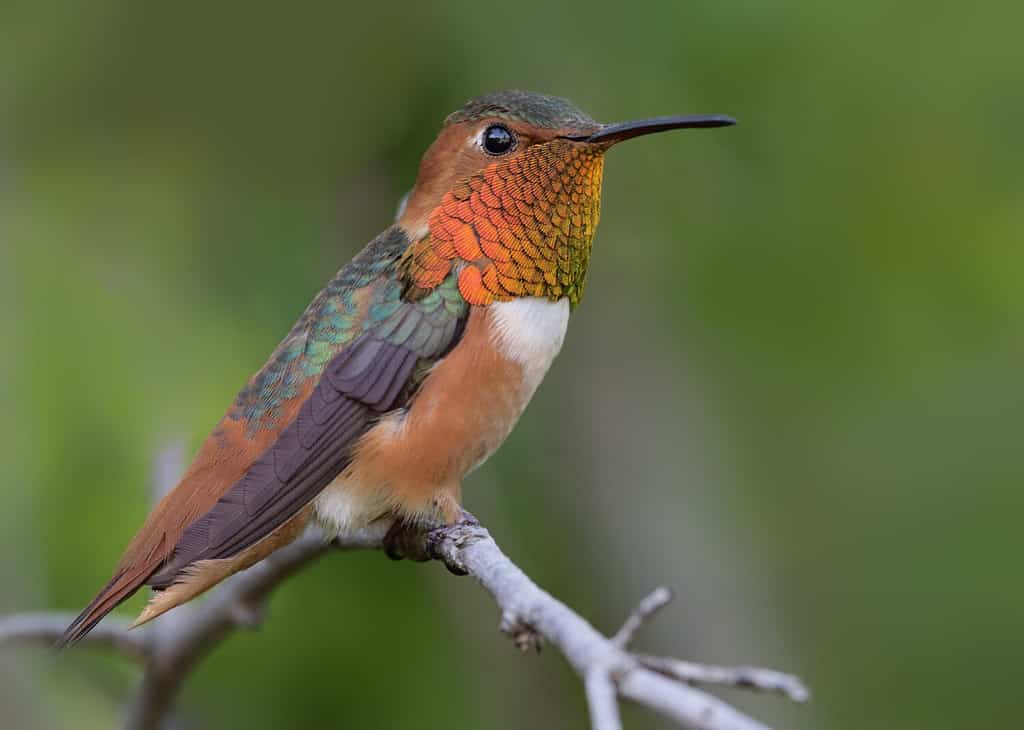
©Angel DiBilio/Shutterstock.com
The orange throat and belly of the Allen’s hummingbird is slightly broken up by a white patch on its chest. Males have an iridescence to their back and throat, and females do too. The females of the species are slightly less vivid in their throat color, but the males and females have a similar pigmentation to their bellies.
These hummingbirds visit a very thin strip of the Pacific coast during the breeding season but mostly live in southern California and Mexico.
4. Western Bluebird (Sialia mexicana)
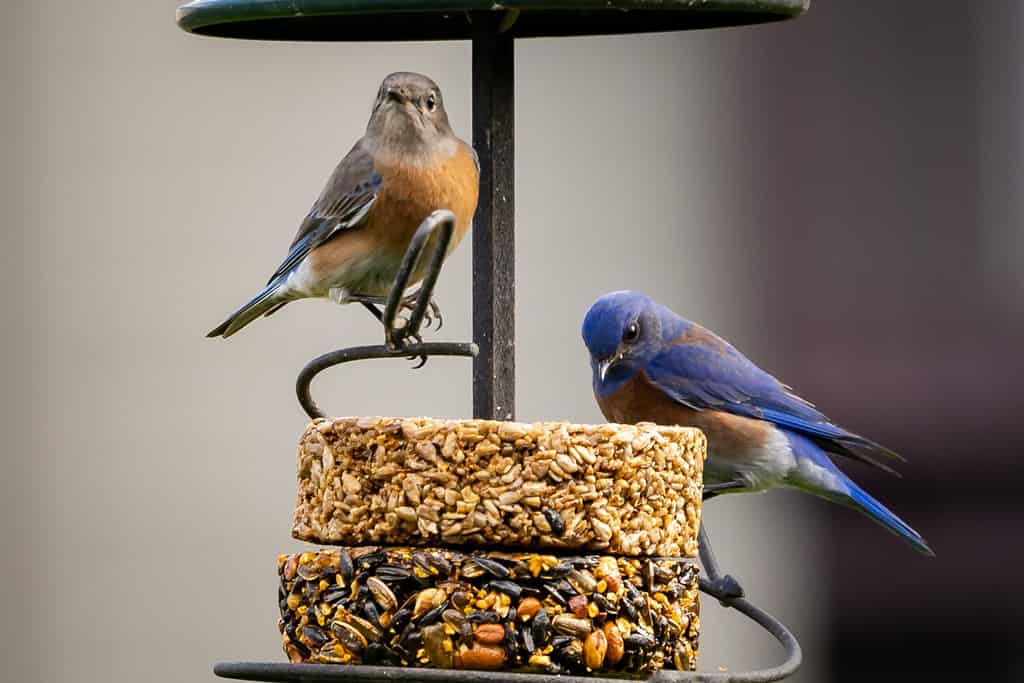
©d murk photographs/Shutterstock.com
Much like their Eastern cousin, the Western bluebird can be found on the opposite side of US and also into Mexico. They physically look very similar, so your geographic region will be the easiest sign. Otherwise, males are still brightly colored blue with intensely orange chests. The main difference between the males of the two related species is the Western bluebird will have a blue-colored throat and some gray on their bellies. Females of this species are a bit darker gray on top than their eastern counterparts, with a dull rusty-colored chest and gray belly.
5. Altamira Oriole (Icterus gularis)
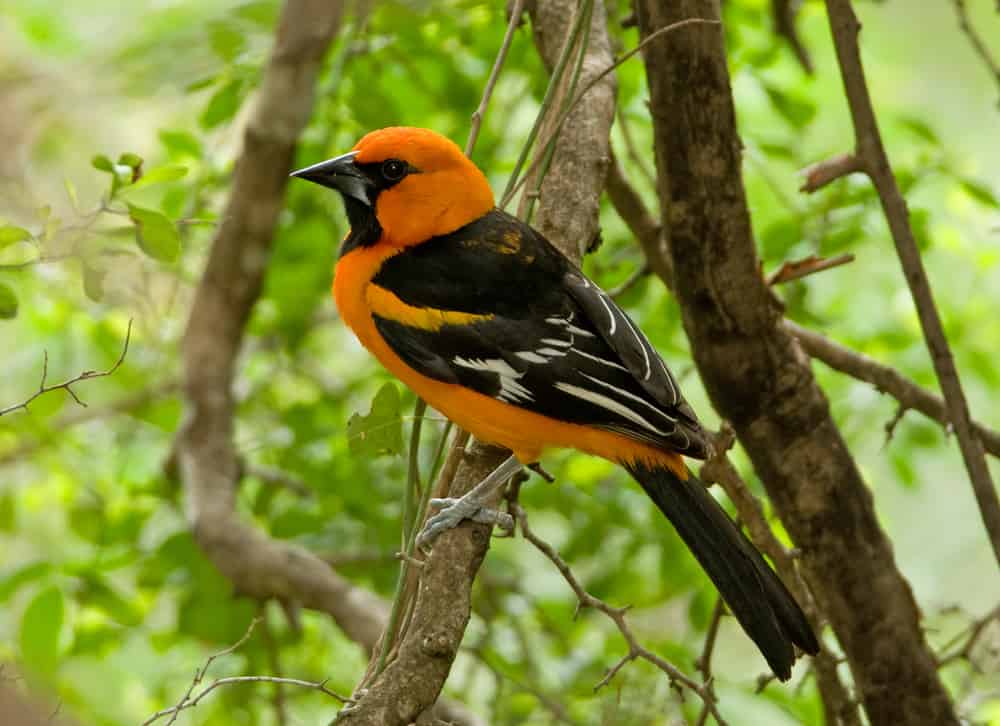
©Gerald A. Deboer/Shutterstock.com
Altamira orioles are a striking orange and black bird with a black beak, face, and neck. This species of bird has a bright orange head, chest, and belly. A female Altamira oriole has a bit of a lighter tone to her colors with her chest and beak being a more dull black or gray color. These non-migratory birds live in Mexico year-round.
6. Bullock’s Oriole (Icterus bullockii)
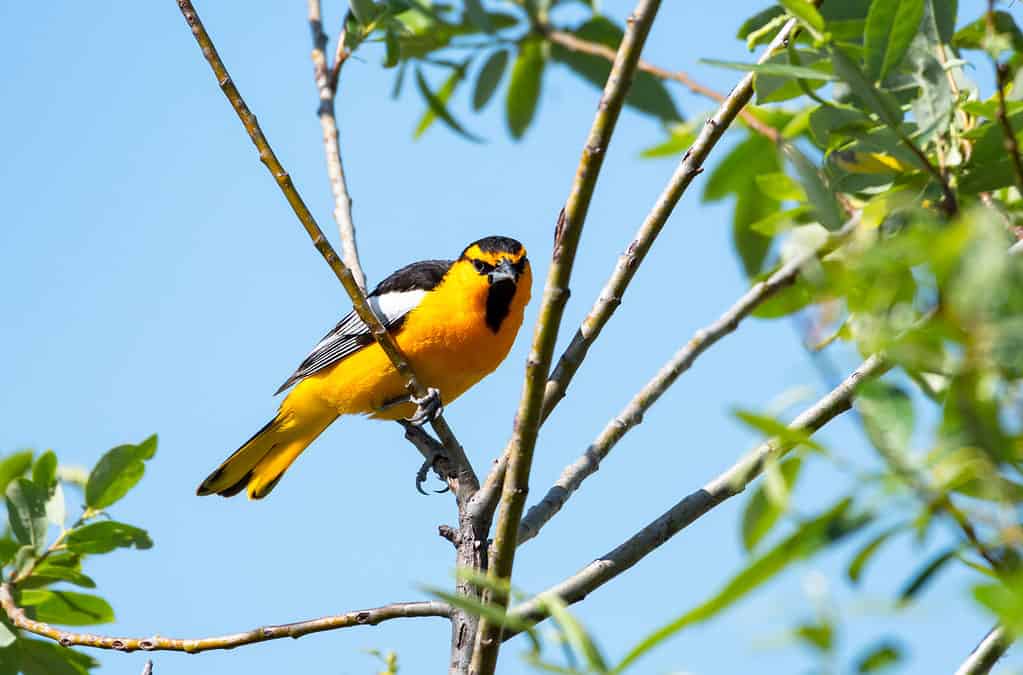
©iStock.com/Chelsea Sampson
This type of orange-chested and bellied bird can be spotted mostly in the western half of the United States and deep into Mexico. A male Bullock’s oriole has a bright orange-yellow underbelly and chest. The top of their heads, backs, and wings are black along with a “mask” of black around their eyes. Beaks are also black in males.
The female Bullock’s oriole still has more gray or brown on her belly and a light orange chest, head, and tail. Her black beak and eye markings are less pronounced.
7. Baltimore Oriole (Icterus galbula)
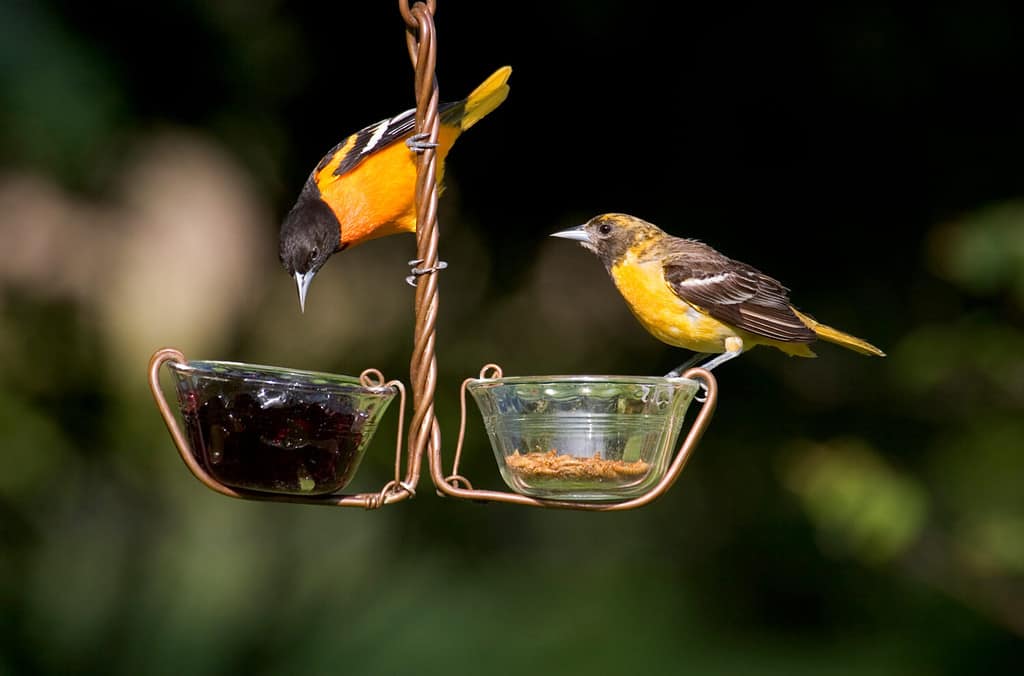
©Danita Delimont/Shutterstock.com
As with the other birds that have orange chests and bellies, the females of this species of oriole is lighter in color than the male. However, in this case, the difference is not as stark. Females still have color from the chest all the way down to their tail. The black color is only slightly more dull than males.
Unlike the Bullocks and Altamira orioles, these birds live mostly in the southern region of Mexico but can extend their reach as far north as some Canadian provinces and, of course, northeastern US states like Maine and Maryland. They don’t live west of Texas, though they might spend some time in the southeastern US when they migrate.
8. Orchard’s Oriole (Icterus spurius)
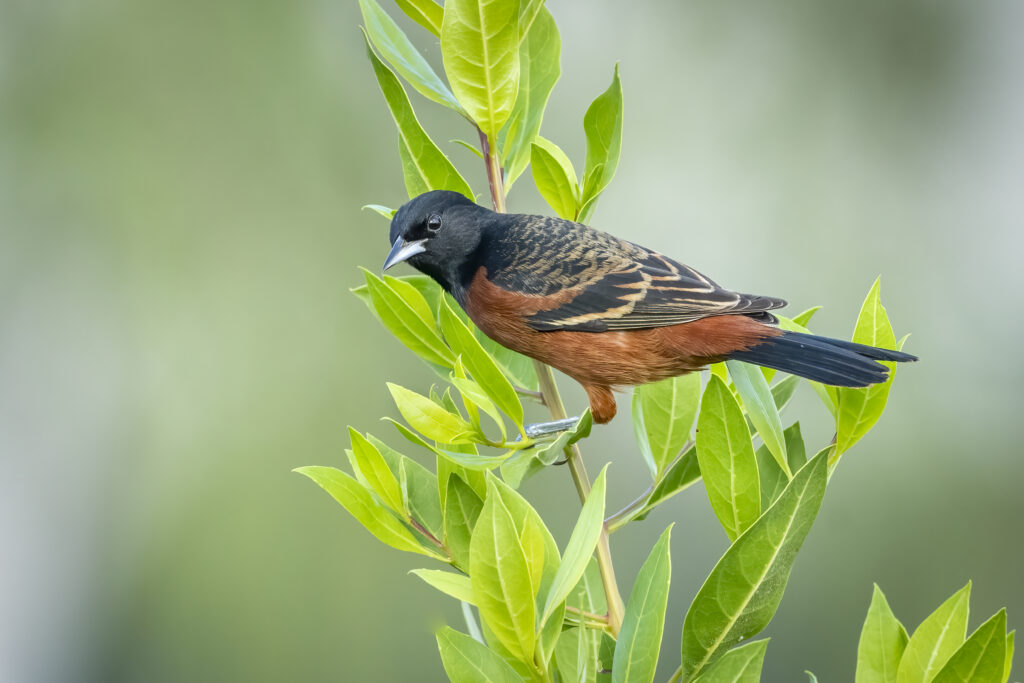
©Tom Cawthon/ via Getty Images
This oriole tends to hang around areas where fruit and nectar is abundant, like orchards. Their geographic range is very similar to that of the Baltimore oriole. The orange belly and chest of this bird look more similar to that of an American robin than other orioles on this list. It’s a rusty-orange color and the head, wings, and tail of this bird is black. There is some orange feathering seen in the wings. Female orchard birds are a dull yellow color with gray only on their wings, and no black head or face.
9. Hooded Oriole (Icterus cucullatus)
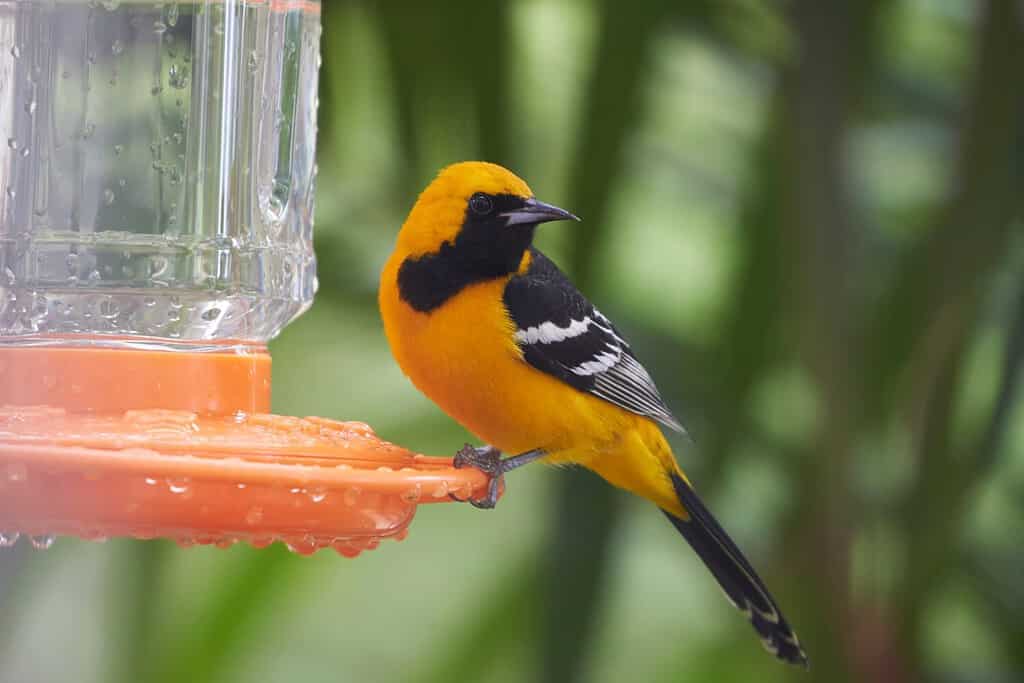
©michael christmas/Shutterstock.com
The hooded oriole has a bright yellow-orange hue to its breast, head, and belly, starkly contrasted by the black chin, neck, wings, and tail. This coloration is what’s typical of the males. Females lack the black chin and neck and are more yellow than they are yellow-orange. Additionally, their wings are brownish, and beaks are pale brown as opposed to the glossy black of the males.
This species of oriole is found in warmer areas, mostly in Mexico and some southwestern states.
10. Barn Swallow (Hirundo rustica)
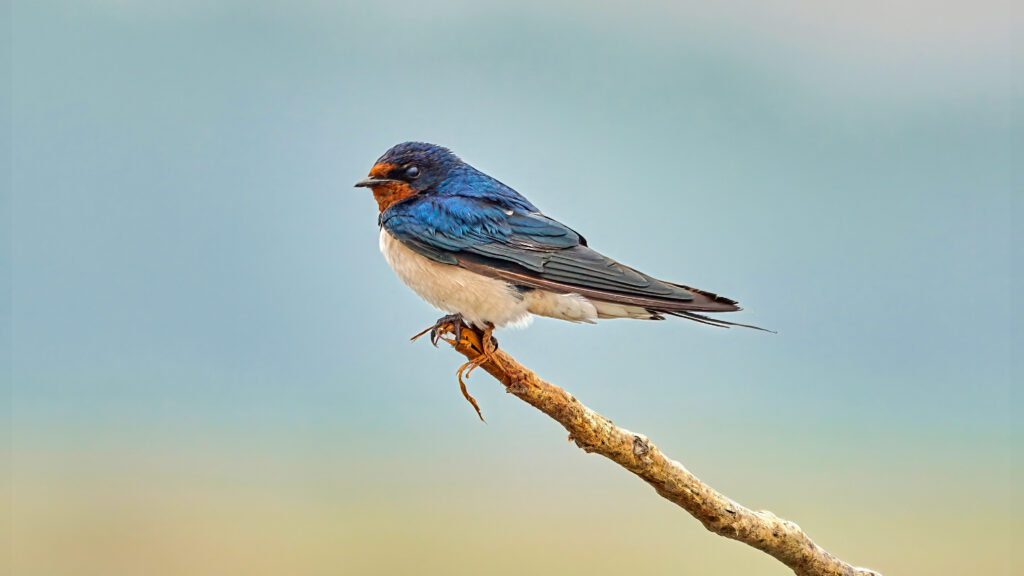
©Kunal Chakravertti/ via Getty Images
Males of the barn swallow species have a deep blue wing color and royal blue back. Their face and necks are a bright rust-orange and their bellies are a lighter orange color. Females have a lightly orangey-brown colored chest and belly and a dusty brown colored back. Barn swallows have a somewhat forked tail which can make identifying this species a bit easier.
The Barn swallow has a range all across North America. You’re most likely to see this bird nesting in buildings and flying low to catch their favorite meal, insects.
11. Varied Thrush (Ixoreus naevius)
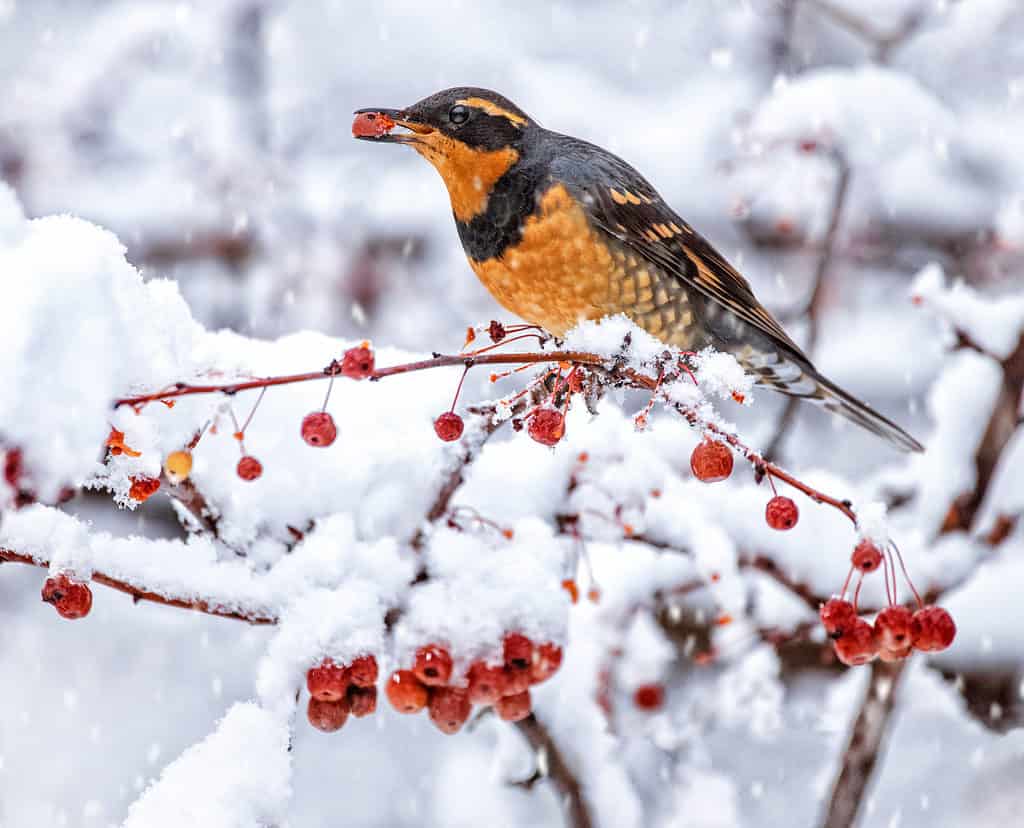
©Annette Shaff/Shutterstock.com
The varied thrush might be confused with an American robin upon a quick glance. This could be because they’re in the same family as robins. However, the varied thrush has more orange feathers in the wings and an orange “eyebrow” in addition to a bright orange chest and belly. This bird also has a much more restricted range than the American robin; it only lives along the Pacific coast of the US. However, it is common in Alaska and western Canadian provinces during the breeding season.
Female and young varied thrush birds have all the same markings as an adult male but with less brightness to their orange and black colors.
12. Blackburnian Warbler (Setophaga fusca)
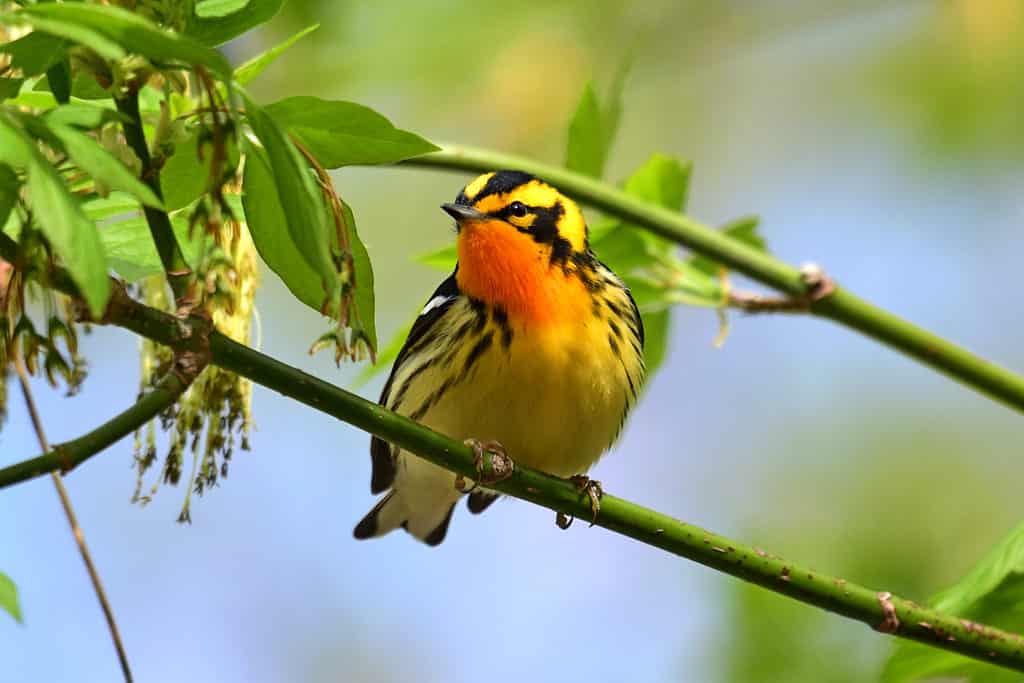
©Joel Trick/Shutterstock.com
The Blackburnian warbler is a multicolored songbird with a radiant orange throat and yellow chest, at least for the males of this species. They also have many black stripe markings along their head, back, and wings. Females are almost entirely yellow with a light gray or brown coloration to their wings. Both sexes have white stripes on their wings, too.
Blackburnian warblers are common in the eastern half of the United States. They also migrate to the east coast of Mexico. This species will breed in the lower parts of Canada and then spend their non-breeding time in South America.
13. Black-headed Grosbeak (Pheucticus melanocephalus)
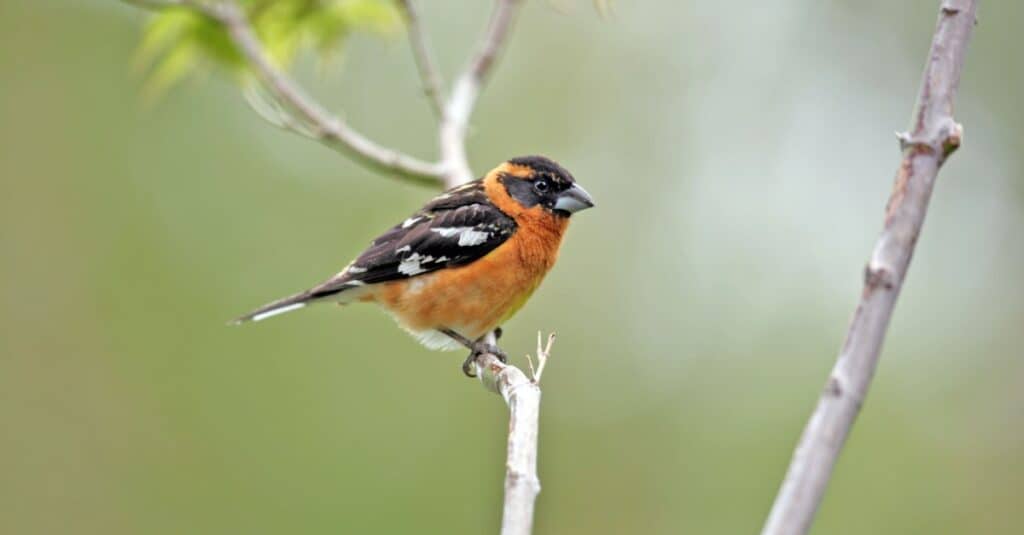
©iStock.com/ltterry
This orange-bellied and chested bird sports a black coat along its wings and a stripe of black along the top of its head and around its eyes. The males are strongly protective of their tree nests and incubate the eggs as much as the female does. Female black-headed grosbeaks look very similar to the males but with a more muted color, as is typical for birds.
Black-headed grosbeaks are widespread in the western half of the US and in Mexico. Only in a small area of Mexico do these birds live year-round.
14. Orange Breasted Waxbill (Amandava subflava)
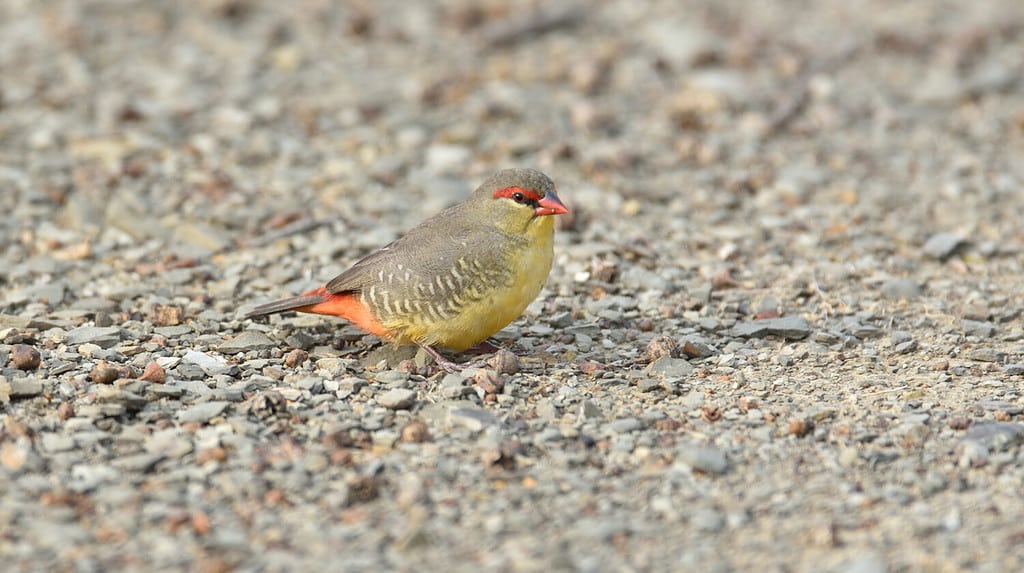
©Clayton Burne/Shutterstock.com
The yellow-orange chest and belly of this waxbill species and orange rump make identifying this bird relatively easy. The red-beak males have along with a red arch over their eyes can give you double assurance that what you’re seeing is an orange-breasted waxbill. Females start out somewhat similar in color, but this becomes more unremarkable as they age.
Unless you travel outside the US, you might never encounter one of these orange-breasted waxbill birds. Their range is all of sub-Saharan Africa but can be found in aviaries in Europe and Australia.
15. Red Knot (Calidris canutus)
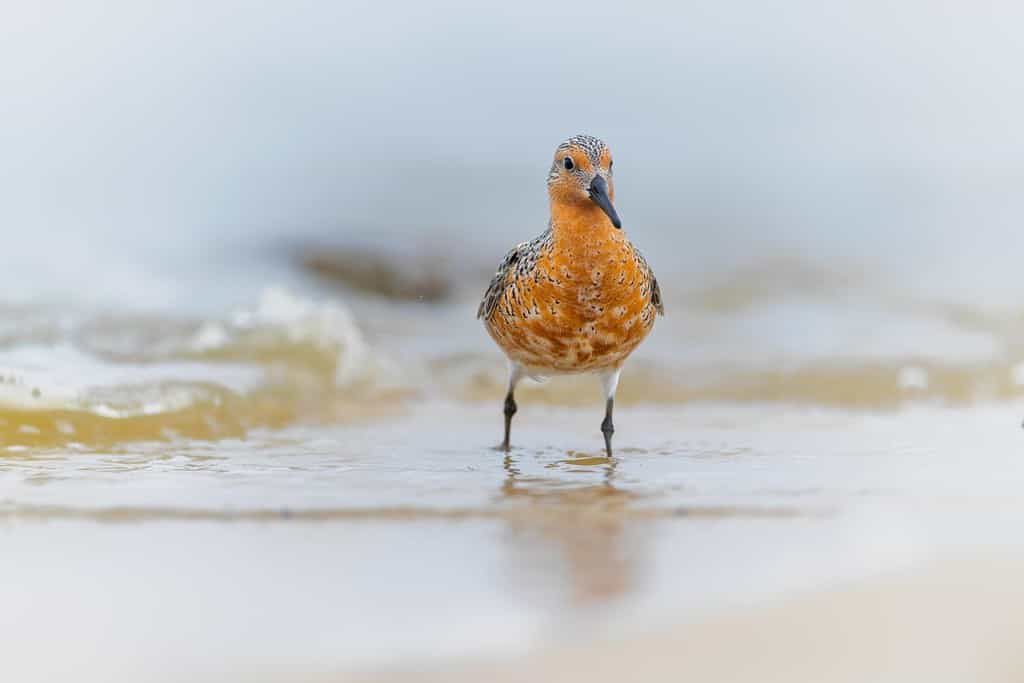
©Buvana Bala/Shutterstock.com
Red knot birds have spotted or speckled backs and wings and a somewhat speckled, orangey-red chest and belly. They are sea-faring birds that live around the coasts of Canada and Alaska. Female red knot birds are more white and gray in coloration, saving the orange belly for the males. They have specialized organs at the tip of their bill to help them find invertebrates below the sand.
Due to their environment, these are ground-nesting birds.
16. American Woodcock (Scolopax minor)
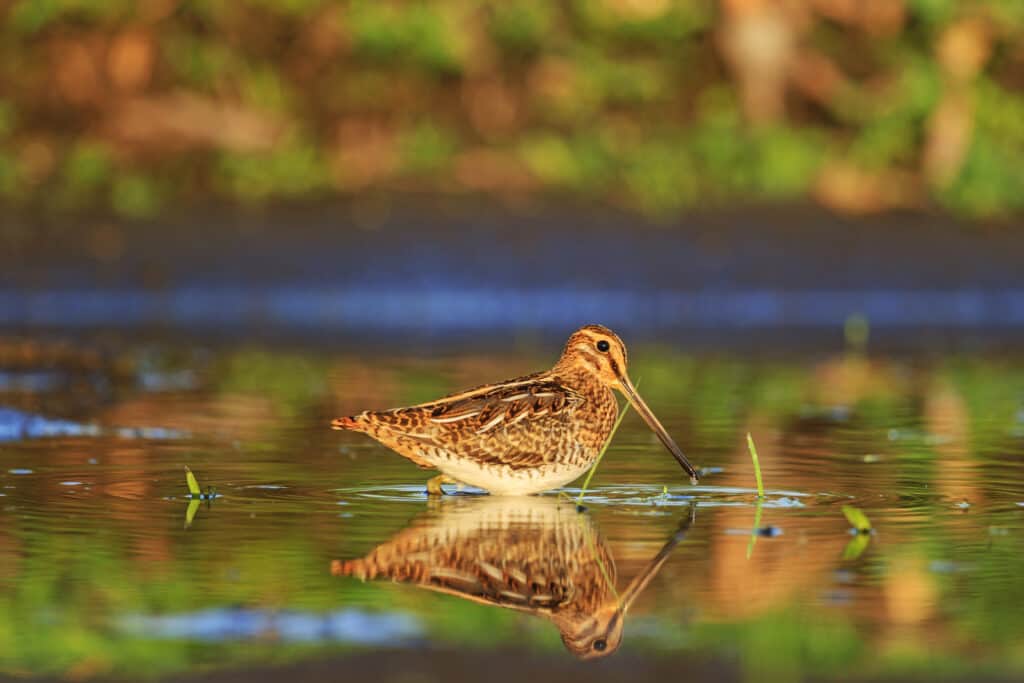
©iStock.com/drakuliren
The American woodcock spends a lot of time in forests. Their long bill can poke and prod in soft soil to get their dinner. The males and females of this species look very similar with their mottled brown and white top colors leading into a cinnamon-orange breast and belly. Their inconspicuous colors help them blend into their surroundings. Since they mostly search for food on the ground, their eyes are slightly higher on their head than other birds.
These birds live mostly in the eastern half of the United States.
17. Red-breasted Nuthatch (Sitta canadensis)
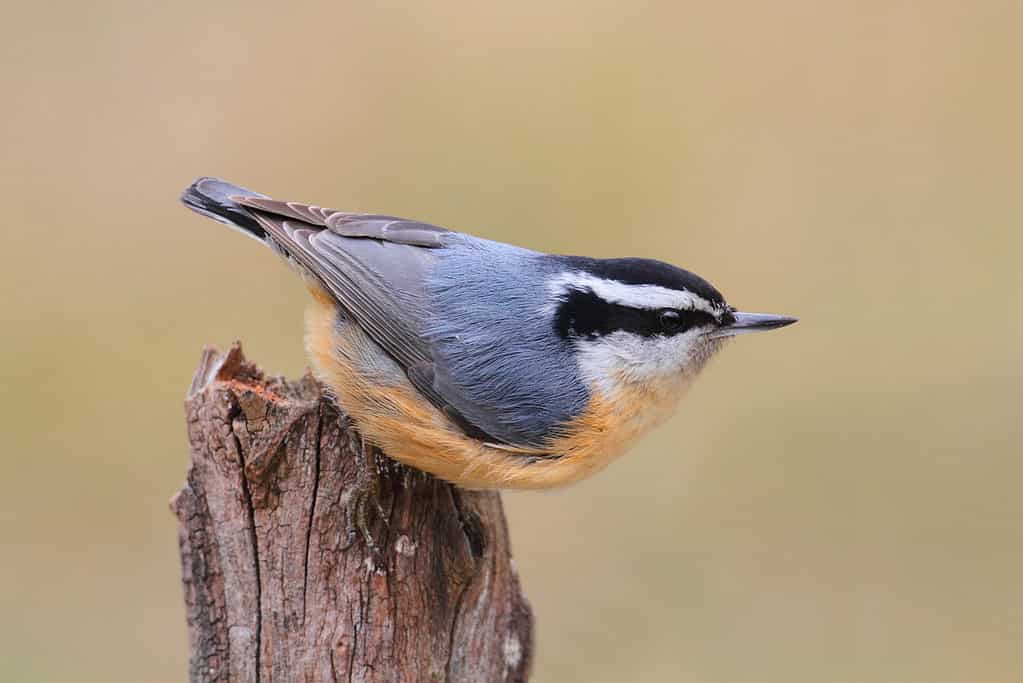
©iStock.com/SteveByland
Red-breasted nuthatches are slightly less bright in color than some of the other species listed here. However, they have an orange chest and belly underneath a steely-blue top half. Notably, they have black stripes going horizontally across the top of their heads and eyes against a white background. Female red-breasted nuthatches have an unremarkable color to their bellies. They still have the same facial markings.
These birds are common all throughout the United States and Canada.
18. Lazuli Bunting (Passerina amoena)
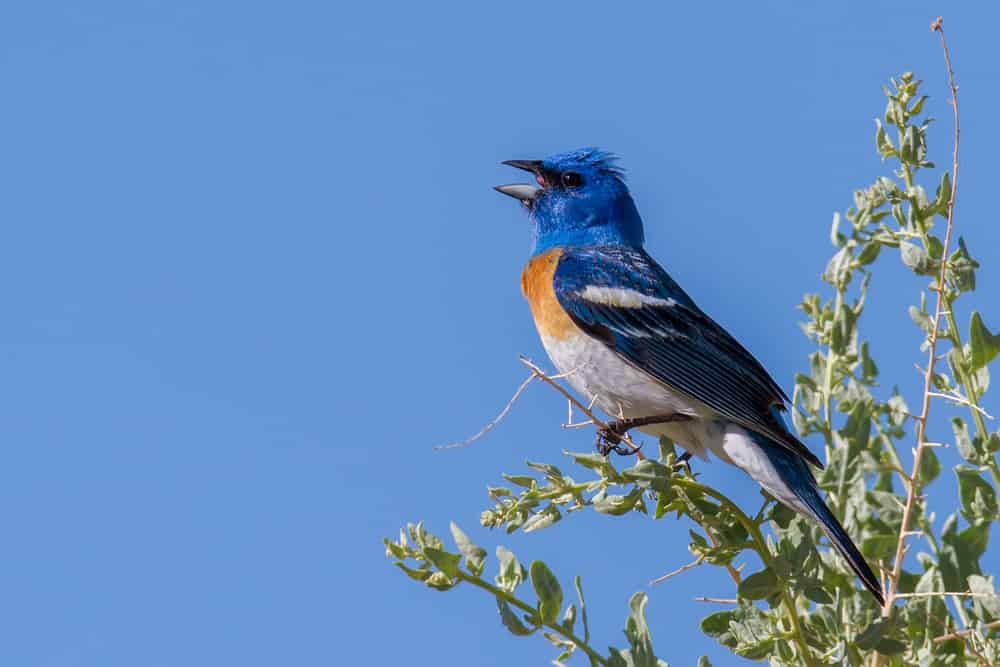
©Ernest A Ross/Shutterstock.com
This species of Bunting has a bright orange chest leading slightly into their belly. Their back and wings shine like the lazuli gemstone. Females are less of a spectacle: they’re mostly a gentle brown with some darker brown shades near their heads and wings.
Lazuli bunting birds live in the western half of the United States and Mexico. After breeding, they molt their colorful (and not so colorful) feathers while they make their way to the warmer, more southern territory.
19. Rufous Hummingbird (Selasphorus rufus)
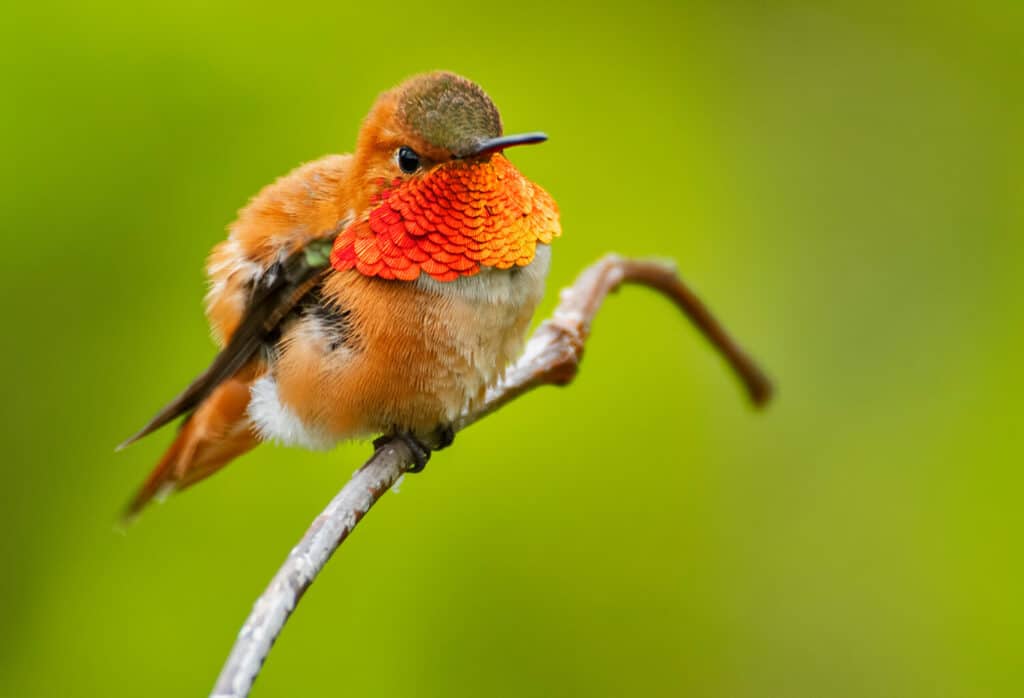
©punkbirdr/Shutterstock.com
Male Rufous hummingbirds are the bright, vivid shades of orange on their chests, bellies, and heads. Their neck feathers are fiery orange-red. Females sport a coppery, flat orange color and olive green on their chests. Both have a very straight-shaped bill with dark brown on their wings.
You can find this species along the Pacific side of the US with their range going down into Mexico and up to Alaska. They move more east towards the Rocky Mountains for the fall.









